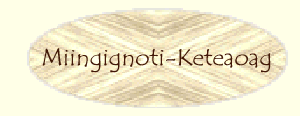
and the International Border
The WABANAKI are peoples and Nations inhabiting the eastern costal regions of what's called by "euro-north americans" as the maritimes of "canada" and the northeast and mid-atlantic areas of the "united states." To the WABANAKI, these are our Homelands since the beginning of our Creation. For over 15,000 years, the WABANAKI have intimately known these areas as WABANAKIK, and in the many dialects of our Peoples. WABANAKI Spirituality, Culture, Ceremony, Language, Sociology, and Science have come from our intimate connection to these lands. The free translation of the terms WABANAKI, WAMPANOAG, and WAPPINGER all refer to"the People of the Dawn-Land" or" the People of the Land of the First-Light".
The WABANAKI are composed of hundreds of OTAMASH/communities and WUTOTIMOINASH/Nations, out of which several KITCHITEASHYEUONKASH/ Confederacies of Nations exist. Some of the most well-known WABANAKI Nations are the MicMac, Maliseet, Passamaquoddy, Penobscot, Pennacook, Mohegan, Deleware, Pequot, Roanoke, and Powhatan. Place names of our Peoples include "Miramichi", Nashwaaksis", "Quebec", "Gaspe", "Massachusetts", "Connecticut", " Chesapeake", "Katahdin", "Aroostook", and "Manhattan". Some prominent WABANAKI vocabulary includes "skunk", "tomahawk", "pow-wow", "wig-wam", "moose", "raccoon", "toboggan", "succatash", "squash", "pumpkin", "eskimo", and "caribou".
Throughout history, the WABANAKI continue to remain a distinct and formidable presence in these lands.
At the closure to the american revolutionary war, the Treaty of Paris, 1783, established the present international boundary between "canada" and the "united states." This border was created and laid within WABANAKI Territories without the approval and participation of WABANAKI Confederate authorities. Vehement protests of this imposition by WABANAKI and the other Indigenous Nations culminated with the Treaty of Amity, of 1794, commonly known as the Jay Treaty. This treaty conducted principally with the "united states" and the british crown, established freedom of movement for the citizens and subjects of these respective nations. It also recognized the Aboriginal mobility rights of Indigenous Nations to freely pass and repass at will, their territories without any regard to the border.
Despite the rule of law established by various royal proclamations, international and Indigenous Treaties cross-border mobility rights of WABANAKI Nations and Peoples continued to be hampered, not respected, and sometimes obstructed. As "american" courts and governments continue to recognize legal and binding obligations to respect such mobility, the "canadian" government hedges their responsibilities on grounds that they were not signatories or legislation by the "canadian" parliament has yet to effect this treaty.
Consequently, American Indians born on the "canadian" side can pass and repass the border, live, seek employment, attend school, receive social assistance, and basically possess dual citizenship in the "united states." However, American Indians born on the "american" side cannot enter into "canadian" ports without first acquiring "canadian" visas or applying for immigration status. The Aboriginal rights of mobility, freedom to associate, rights to practice and maintain spiritual and ceremonial rituals, the integrity of Homelands and traditional/customary life are not recognized as applying to WABANAKI born in the "united states." This effectively discredits WABANAKI Spiritual Life, traditional economies, and territorial and social integrity; separates WABANAKI Families, Communities, and Nations; ignores the principals and spirit of the rule of law established through international and Indian treaties.
|